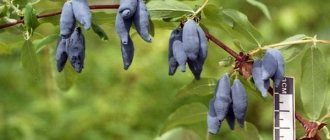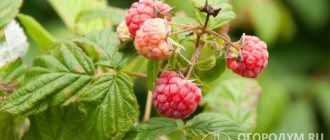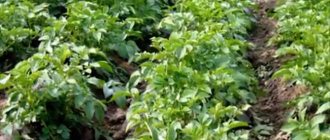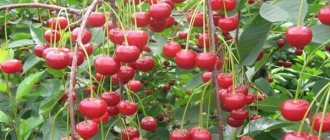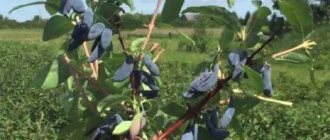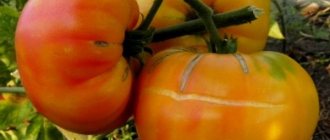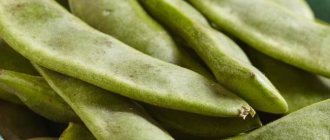The Blue Spindle honeysuckle variety is distinguished by the sweet and sour taste of large berries, the decorative appeal of the bush and its low maintenance requirements. From the article you will learn how to select and plant a plant, what to do to reap a good harvest and other features of growing Blue Spindle.
honeysuckle variety "Blue Spindle"
The variety got its name “Blue Spindle” for the shape and color of the berries.
According to tasters, the taste of the berries of the Blue Spindle honeysuckle variety depends on the growing region
Description and technical specifications
Table of main characteristics of the variety:
| Bush height, m | Frost resistance, °C | Fruiting period, years | Maturation | Productivity, t/ha | Tasting assessment, score |
| 1-1,5 | up to -45 | 20 | early | up to 7 | 3,5-4,3 |
Bush
The bushes are vigorous and quite large. The crown is round in shape, medium thick. The shoots are green, tinged brown in the sun, thin, without pubescence, directed upward at an acute angle. The leaves are large, folded along the midline, in the shape of an elongated oval with pointed ends. The color is dark green.
Fruit
The large berries grow up to 3 cm in length and more than 1 cm in diameter. They are shaped like a spindle, with a flat base and a pointed top, lumpy. The skin is dense, blue, almost black, covered with a thick waxy coating.
The pulp is tender, sweet and sour. It contains:
- dry matter – 12.1-12.7%;
- sugar – 6.4-7.6%;
- acids – 2.2-3.1%;
- ascorbic acid – 18.5-61 mg/100g;
- vitamin P – 386-992 mg/100g;
- pectin – up to 1.14%.
Fruiting and productivity
The honeysuckle bush begins to bear fruit at the age of 4-5 years. Although you can collect the first few berries already the next year after planting.
A plant with a short growing season. It blooms very early, during the first spring thaw. Flowers are not afraid of spring frosts.
The berries ripen unevenly - from the beginning of June until its third week. In warmer climates - from the end of May.
The yield has received good estimates and can reach 1.2-2 kg per adult plant.
An overview of the Blue Spindle honeysuckle variety is presented in the video below:
The older the plant, the greater its yield.
Pollinators
The Blue Spindle variety is self-sterile. If other varieties of honeysuckle are not planted nearby, the harvest will not be possible.
The most successful pollinating varieties include:
- Blue Bird;
- Azure;
- Cinderella;
- Kamchadalka;
- Tomsk.
Pollinator plants are planted on the windward side, either in groups or alternating with Blue Spindle bushes.
The best yield indicators were recorded when 3-4 varieties of honeysuckle were planted in 1 plot.
Productivity of the Blue Spindle variety
The Blue Spindle honeysuckle variety begins to bear fruit 4-5 seasons after the seedlings are planted in a permanent place.
The berries begin to ripen around the 13th-20th of June (depending on the region in which the plant is grown). The fruits ripen unevenly, so the harvest stretches for 10-12 days, sometimes for a longer period.
Photo of honeysuckle harvest Blue spindle
The yield of the Blue Spindle honeysuckle variety is stable and abundant regardless of the region of cultivation and amounts to 1.9-2.1 kg per bush.
Important!
Ripe berries do not adhere well to the petioles and are prone to shedding, so if you do not collect ripe fruits on time, you can lose up to 1/5 of the harvest.
Advantages and disadvantages
The main advantages of the variety include:
- ripening time;
- stable and high yield regardless of growing conditions;
- size and taste of berries;
- ease of care;
- frost resistance;
- drought resistance;
- high resistance to pests and diseases;
- decorative appeal, can be planted as a hedge or to decorate unsightly structures.
There are much fewer disadvantages, these include:
- in the absence of precipitation, the berries become bitter;
- high shedding of ripened berries;
- Pollinators are needed for the formation of the ovary.
Advantages and disadvantages
The creators of the variety took care of the advantages of the plant, thanks to which honeysuckle is popular:
- Early ripening.
- Excellent yield regardless of growing region. About two kilograms of gray fruits are harvested from the bush annually.
- The Blue Spindle variety attracts with its large, tasty berries.
- The bushes are compact, easy to care for, and do not require shelter for the winter.
- Drought-resistant and frost-resistant. They can withstand temperatures down to -45 degrees, fruits set even at 8 degrees below zero.
- They practically do not get sick and are not affected by pests.
If we talk about the shortcomings, they are minimal:
- the appearance of bitterness in berries in dry years;
- crumbling, which leads to a loss of 10-15% of the yield.
Growing
Growing Blue Spindle honeysuckle is not difficult. All a gardener needs is to become familiar with some of the nuances and adhere to the general rules of plant care.
How to choose healthy seedlings?
Whether honeysuckle will take root in a new place depends on the choice of a healthy seedling. It is best to purchase them from a nursery.
Please note when purchasing:
- the plant must be 2 years old;
- the root system must be well developed;
- cuttings should reach a height of 25 cm;
- the seedling itself should not be more than 1.5 m, since taller plants do not take root well;
- there should be no broken branches on the seedlings;
- there should be no signs of illness.
When purchasing plants in pots, pay attention to the condition of the roots; they should entwine the earthen ball to a moderate extent, not emit unpleasant odors and look healthy.
Landing dates
The timing and timing of planting is influenced by the condition of the root system of the seedling:
- Open root system. Plan to plant in the fall. The best time would be a month before the expected frost. If such bushes are planted in the spring, the plant will spend all its energy on the growth of leaves and shoots, and the root system will remain underdeveloped. The honeysuckle may begin to hurt or even die.
- Closed root system. Such seedlings can be planted at any convenient time of the year.
Site selection
Since the Blue Spindle honeysuckle bush will grow in one place for a long time, you should choose it responsibly.
Adhere to the following rules:
- Landing place. Choose a sunny location with protection from the wind, such as against the south wall of a house or other structure.
- Groundwater. Should not be closer than 1 m from the surface, so as not to damage the root system.
- Availability of nutrients in the soil. If you plant honeysuckle on poor soils, add nutrients to the planting hole. Dry branches or wood chips work well for this. During the process of decay, they will provide nutrition to the plant, and the process of decay itself, accompanied by the release of heat, will warm the roots.
Step-by-step instructions for planting a bush
Planting seedlings includes the following steps:
- Marking rows. Divide the area into rows if there should be a lot of plants. Leave a distance of 2 m between rows.
- Digging holes. Dig holes 40-50 cm wide and deep (on clay soils - deeper to lay 10-12 cm of drainage) at a distance of 1-1.2 m from each other in each row.
- Fertilizer. Place drainage in the bottom of each hole, if necessary. Next, mix the soil with compost (1 bucket), ash (300 g), potassium sulfate (30 g) and superphosphate (100 g).
- Root distribution. Make a mound of fertilizer inside the hole. Distribute the roots over its surface and pour water in the volume of 1 bucket.
- Dropping. Cover the roots with soil, deepen the root collar by 5-7 cm.
- Tamping. Lightly compact the soil around the bush and pour out another bucket of water.
- Mulching. Mulch the planting site with a layer of 5-7 cm. Use light mulch, for example, fallen leaves, peat, humus, sawdust. This will help retain moisture inside the soil.
Seedlings with a closed root system are not deepened when planted.
Care
Subsequent care for honeysuckle includes simple agrotechnical measures.
We recommend reading the article on how to care for honeysuckle in the autumn.
Irrigation scheme
Blue Spindle Honeysuckle is a drought tolerant plant. But, with little rainfall, the berries begin to taste bitter. Therefore, in the driest regions or during dry spring and summer, pour 2-3 buckets of water under each bush every week.
Watering is important during flowering and fruit ripening.
When, how and what to feed?
Apply fertilizing 4 times per season:
- Spring. Apply the first fertilizing before the snow completely melts. Under each bush, pour 0.5 buckets of compost or humus after mixing it with mulch.
- During the period of bud formation. Sprinkle 0.5-1 cup of wood ash under each plant.
- At the end of summer. After harvesting, when the buds are forming for the next year, in August, apply ash fertilizer again.
- During the period of cessation of growth. In the fall, in September-November, make a furrow around the bush to a depth of 20 cm. Add 1 tbsp. spoon of superphosphate and cover with soil. Water the plant.
Trimming and shaping
In the first 2-3 years, the crown is actively formed, the plant grows in height. After this period, the apical buds die and the lateral buds begin to grow actively. If the bushes are not pruned in time, they will become very thick, which will negatively affect fruiting.
During the first 2-3 years of growth, the bushes do not need any pruning other than sanitary pruning.
Carry out pruning to form bushes according to the following rules:
- Sanitary pruning. Performed as needed until the age of 6 in the fall or early spring. Branches that grow inward and toward the ground, that are broken or diseased, are cut off. For this purpose, the skeletal branches are shortened by a third.
Crooked branches are cut out and pulled out of the bush in parts. Pulling an entire branch can damage the plant.
- Thinning. Conduct it no earlier than the 4th year of plant growth in late autumn.
- For the purpose of replacement. Carry out on old plants. Every year, several of the oldest branches are cut out in order to replace them with young shoots.
- Rejuvenation. The period of this pruning is determined by the decrease in the yield of the old bush. Cut off all the branches, leaving a stump 20-30 cm high. New shoots will grow on them and thus fruiting will resume.
No more than 15 skeletal branches are left on each Blue Spindle bush.
Loosening
Since the root system of the Blue Spindle is not located far underground, loosening under the bushes is not carried out.
Loosening can damage the superficial root system of Blue Spindle Honeysuckle.
Place mulch of hay, straw or sawdust around the root collar to prevent the soil from drying out and cracking.
If the soil is still dry, pierce it with a fork in several places, and then lay mulch.
Preparing for winter
Honeysuckle is a plant with a very high degree of frost tolerance. It does not freeze even in the harshest winters, so it does not require special measures to prepare for wintering.
Honeysuckle Blue spindle overwinters without additional shelter.
Trimming and shaping
Forming the Blue Spindle is easy. Firstly, the bush of this variety is not too dense, and secondly, any honeysuckle does not like pruning. Berries are formed on annual, not yet lignified growths. If you shorten the branches, you will deprive yourself of the harvest. Therefore, the formation consists of only two stages:
- For the first 3 years after planting, the bush should grow as it wants.
- Then annually cut out 2-3 of the oldest branches near the ground into a stump or shorten them to a strong vertical shoot.
Old branches differ from young ones: they are thicker, coarser, their bark has a dark tint, but the main feature is that weak (short) growths grow on such branches, or there are none at all.
Many people mistake cracked and hanging bark in ribbons as a sign of aging or disease. However, this is a biological feature of honeysuckle; it also appears on young branches.
Rejuvenating honeysuckle pruning: old branches are shortened to strong vertical growths
Simplicity of formation does not negate annual sanitary pruning and thinning. Every spring, trim off all the branches growing inside the crown and down to the ground. If the branches cross, interfere with each other, or shade, cut out the most clumsy one that spoils the appearance of the bush. It must be removed in parts, that is, by cutting it into pieces. If you pull crooked branches entirely from the bush, you will damage the rest. When pruning, try to give the bush a beautiful appearance, that is, leave the shoots equidistant from each other, directed in different directions and upward. Cut back those growing low along the ground. Such branches are good for propagation by horizontal layering, but they usually do not bear berries.
Recent Entries
5 working ways to use tar in the garden 7 indoor plants that help you get married even in adulthood Indoor plants that can bloom in trouble
Video: basic principles of pruning honeysuckle
Reproduction
Methods suitable for propagating honeysuckle at home are:
- Cuttings from annual shoots. To do this, young shoots are plucked from the mother bush with their heels. They are rooted in a greenhouse. But this method is difficult for a novice gardener, because it requires certain skills and maintaining conditions, for example, high air humidity throughout the month.
- Bush divisions. Part of the peripheral root system with young shoots is separated from the old bush.
- By layering. The young branch is buried in soil and waiting for roots to appear in its lower part. After this, they are separated from the mother bush.
Growing honeysuckle from seeds will not work. Almost all seedlings die. Of the few that survive, wild animals will grow up, having lost their breeding genetics. Their berries will not be edible.
Diseases and pests
Many gardeners note the high resistance to diseases and pests of the Blue Spindle variety. But, there are some pests that can attack bushes.
Sometimes cracked and drooping bark is mistaken for a manifestation of the disease, but this is the biological structure of the honeysuckle bark.
Common diseases:
- Cladosporiosis or brown spot. The fungal disease appears on the leaves of the lower tier, then covers the entire plant. Brown spots appear on the upper side of the leaf, between the veins. A gray velvety coating forms on the underside of the spots.
- Megaloseptoria or blackening of branches. The fungus develops in conditions of high humidity. As the buds develop, they turn black and die.
- Powdery mildew. Fungal infection. It manifests itself in the formation of whitish-gray spots in the form of a coating; over time, liquid appears on them, resembling dew drops.
- Tubercularosis. The disease is of fungal origin. The first manifestations can be detected on the inside of the leaf in the form of red lumpy spots. Then the branches of the bush are affected.
You can overcome diseases with the help of a 3-4% solution of Bordeaux mixture or the drug Skor.
Honeysuckle berries are loved by honeysuckle fingerwing caterpillars. You can fight the pest with the help of drugs:
- Confidor;
- Inta-vir;
- Decis;
- Actellicom.
Preventive treatments against pests and diseases are not carried out.
Honeysuckle Blue Spindle: reviews from those who grow the berry
Katya, 32 years old, Novosibirsk region: Several years ago my husband and I bought a summer cottage with a garden house and immediately began searching on websites for varieties of fruit trees and shrubs. On one of the sites I saw the Blue Spindle honeysuckle variety and decided to plant it on the site. In addition to the seedlings of this variety, I purchased 4 more seedlings of other varieties of this berry crop so that the shrubs would be better pollinated. After 3 years, we have already harvested the first harvest from all these berry perennials. It was very tasty.
Svetlana, 48 years old, Yekaterinburg region: Different varieties of honeysuckle have been growing on my site for more than 6 years, including the Blue Spindle variety. I make jam from the harvested crop, and also grind it with sugar - in winter, all these “supplies” are used up in my family with a bang.
Ripe honeysuckle fruits contain a large amount of vitamins; moreover, they ripen quite early and are practically the first ripe berries in the garden. These berries are useful for people suffering from diseases of the cardiovascular system; they cleanse the walls of blood vessels and increase their elasticity. Therefore, having a couple of honeysuckle bushes in the garden is useful not only for older people, but also for younger gardeners. Honeysuckle Blue spindle has many advantages, so it deserves to take a place in any summer cottage.
Harvesting, processing
Ripe berries should be picked immediately. The fruit stem weakens and they do not stay on the branches for long, as a result, you can lose up to 15% of the harvest.
After the first berries ripen, harvesting is carried out every 2-3 days, as they ripen. At the same time, pick the fruits very carefully, as other berries will fall off due to the movement of the branches.
Before starting to collect, place a clean cloth or paper under the bush. The berries that fall will remain on it.
Picked fruits can be stored in the refrigerator for up to 5 days. Fresh berries do not have a sweet taste, so they are consumed by grinding them with sugar.
In addition, Blue Spindle makes excellent:
- compotes;
- fruit drinks;
- jam;
- jam;
- dried berries;
- frozen berries.
Reviews
★★★★★
Olga, 38 years old. 3 years ago I purchased the Blue Spindle honeysuckle bush.
During this time it has grown well. It requires virtually no maintenance, the ground around it is mulched with mown grass, and overwinters without shelter. Every year it pleases us with the earliest large berries. We eat them fresh and freeze them for the winter. Only the fruits must be collected on time, otherwise they will fall off. The Amphora honeysuckle bush grows for pollination. I am very pleased with the plant and plan to plant several more bushes. ★★★★★
Konstantin, 45 years old. I tried these berries for the first time at a friend’s dacha and was captivated by the taste.
The next year, I planted Blue Spindle honeysuckle on my plot. In the first year the plant did not develop very much, but in the second it began to grow. Now, within a radius, the bush reaches half a meter, and up to one and a half meters in height, and has a very decorative appearance. It bloomed profusely in the spring and there were many berries in June. They were collected every 2 days. We tried freezing them and making jam. A big plus is that the plant does not require care - it is enough to water it in the heat and remove weeds. I have never seen any diseases or pests on it. Hide
Add your review
Honeysuckle Blue spindle is a plant with minimal care requirements, rarely susceptible to disease or damage by pests, and winters well in severe frosts. The bush not only consistently produces high yields, but also decorates the area. Gardeners highly value the plant and are happy to plant it on their plots.
0
0
Copy link
History of the variety's creation
This variety of honeysuckle was bred by plant breeders from the Siberian Research Institute of Horticulture named after. M. A. Lisavenko. The original authors are considered to be scientists Z. P. Zholobova, I. P. Kalinina, Z. I. Luchnik. The Kamchatka honeysuckle variety Start was taken as a basis; when developing a new variety, open pollination of seedlings was used.
Photo of honeysuckle Blue spindle
The variety was developed in the last quarter of the last century, and tests of the Blue Spindle honeysuckle were carried out on state varietal plots located in Siberia since 1980 and lasted 9 years. And then in 1989 this honeysuckle was included in the State Register of Russia.
Blue spindle is recommended for cultivation in almost all Russian regions.



